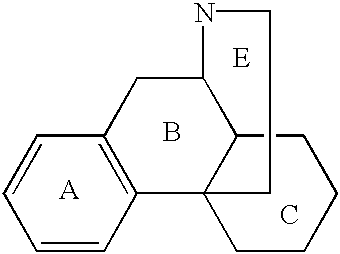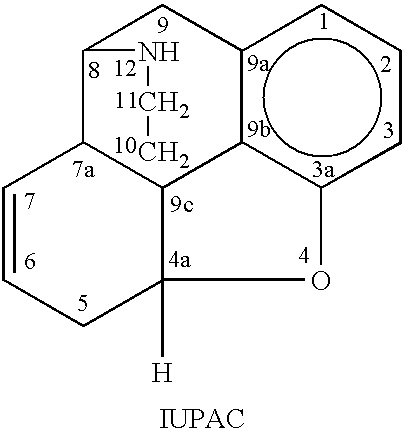Method for preparing oxycodone
a technology of oxycodone and oxycodone ether, which is applied in the field of improving the method of preparing oxycodone, can solve the problem that reference fails to teach a method for producing organosilyl dienol ethers of morphinone ring in commercially practicable yields
- Summary
- Abstract
- Description
- Claims
- Application Information
AI Technical Summary
Benefits of technology
Problems solved by technology
Method used
Image
Examples
example 1
Formation of Codeinone from Codeine
Codeinone was prepared by oxidation of codeine sulfate trihydrate. A reaction mixture was prepared containing codeine sulfate trihydrate (10.4g), de-ionized water (20 g) and isopropyl acetate (87.2 g) at ambient temperature. The reaction mixture was agitated and the resultant mixture cooled to about 20.+-.5.degree. C. Concentrated ammonium hydroxide (18.0 g) was added in several portions and the mixture was maintained at a temperature of about 20.+-.5.degree. C. with stirring. Sting was continued for about 15 minutes, and then a small portion of the aqueous layer was withdrawn to check for pH value, which was to be advantageously maintained between 11.0 and 12.0. The aqueous layer was then separated and re-extracted with isopropyl acetate (35 g). The combined organic layers (isopropyl acetate) were concentrated in vacuo to near dryness at temperature NMT 45.degree. C. The residual isopropyl acetate solvent was chased by adding 18 g of toluene. The ...
example 2
Preparation of Dienolsilyl Ether of Codeinone
Codeinone (6.0 g) with toluene (104 g) was added to a reaction flask equipped with a mechanical stirrer, thermocouple, Dean-Stark trap with condenser attached, and a nitrogen-inlet adapter. The batch was heated to reflux and about 27.7 g (32 ml) of distillate was collected in the Dean-Stark trap. The contents were then cooled to 20.+-.5.degree. C. under a nitrogen atmosphere. A solution of DBU (4.22 g) in toluene (3 g) was added in one portion. Subsequently, a solution of t-BDMSiC1 (4.22 g) in toluene (5 g) was likewise added in one portion. The batch was slowly warmed to 58.+-.3.degree. C. and stirred at this temperature for about 2 hours. Completion of the reaction was adjudged by withdrawing a 20 small sample from the batch, extracting it with a mixture of ethyl acetate and saturated sodium bicarbonate solution, spotting the organic layer on a TLC plate, and then eluting it with a mobile phase of 9:1 mixture of dichloromethane and meth...
example 3
Preparation of Peracetic Acid Solution
14-Hydroxycodeinone was synthesized from the dienolsilyl ether of codeinone by oxidative hydroxylation using a peracetic acid solution preparation. The peracetic acid solution was prepared as follows: ##STR11##
Acetic anhydride (80.0 g) and concentrated sulfuric acid (0.15 g, or about 6 drops) at ambient temperature were added to a clean and dried round bottom flask (3-neck, 250 ml) equipped with mechanical stirrer, thermocouple, nitrogen-inlet adapter and addition funnel. The mixture was cooled to about 10.+-..degree. C. under a nitrogen atmosphere. A 14.0 g of 30% aqeous hydrogen peroxide solution was slowly added through the addition funnel. The addition of hydrogen peroxided was performed drop by drop maintaining content temperature at NMT 27.degree. C. (formation of peracetic acid and the hydrolysis of acetic anhydride are strongly exothermic, cooling is absolutely essential., but over-chilling the batch is not recommended). After complete a...
PUM
| Property | Measurement | Unit |
|---|---|---|
| pressure | aaaaa | aaaaa |
| temperature | aaaaa | aaaaa |
| height | aaaaa | aaaaa |
Abstract
Description
Claims
Application Information
 Login to View More
Login to View More - R&D
- Intellectual Property
- Life Sciences
- Materials
- Tech Scout
- Unparalleled Data Quality
- Higher Quality Content
- 60% Fewer Hallucinations
Browse by: Latest US Patents, China's latest patents, Technical Efficacy Thesaurus, Application Domain, Technology Topic, Popular Technical Reports.
© 2025 PatSnap. All rights reserved.Legal|Privacy policy|Modern Slavery Act Transparency Statement|Sitemap|About US| Contact US: help@patsnap.com



